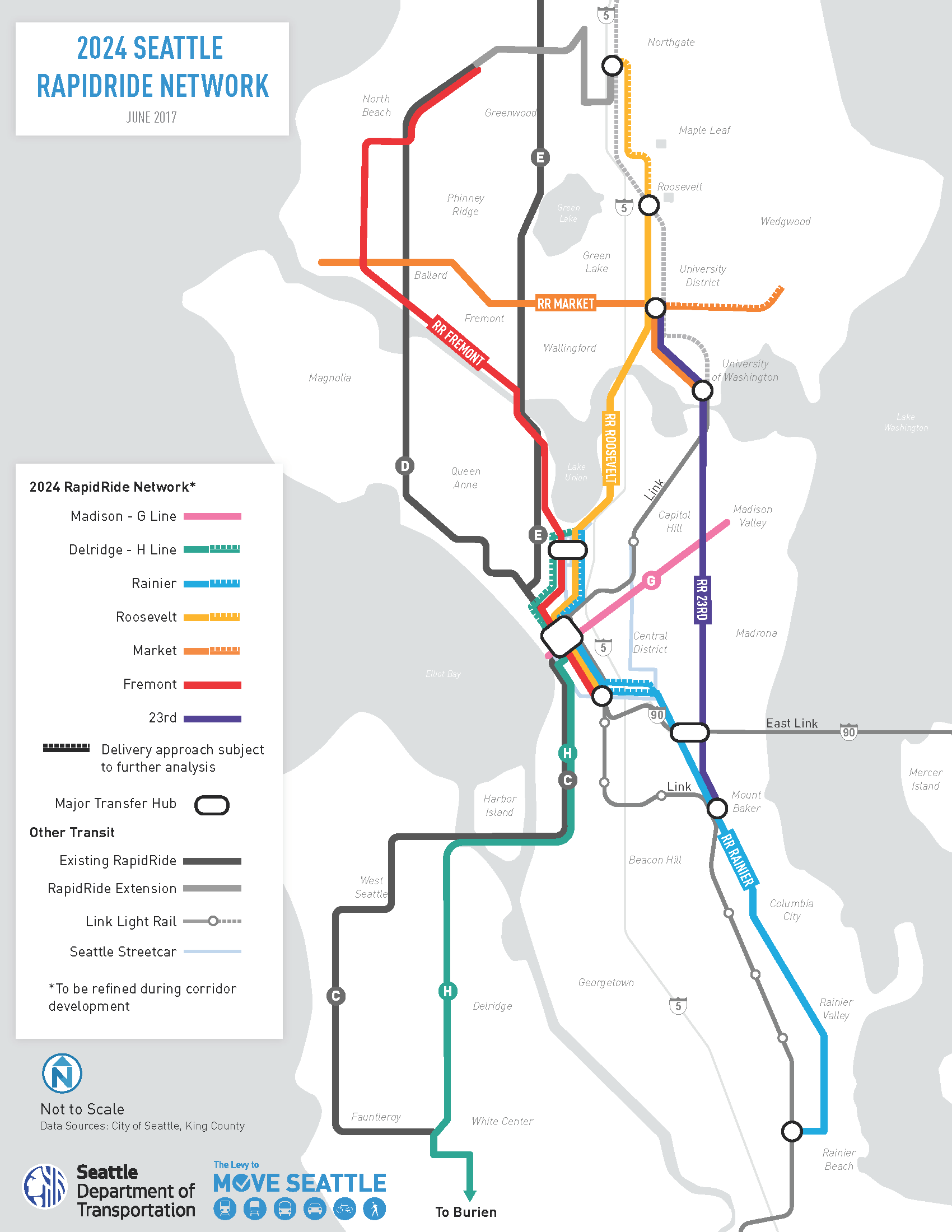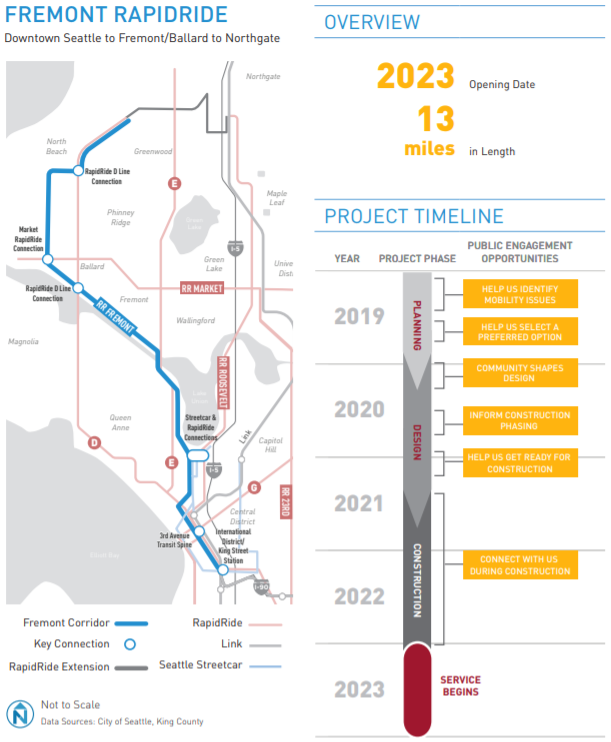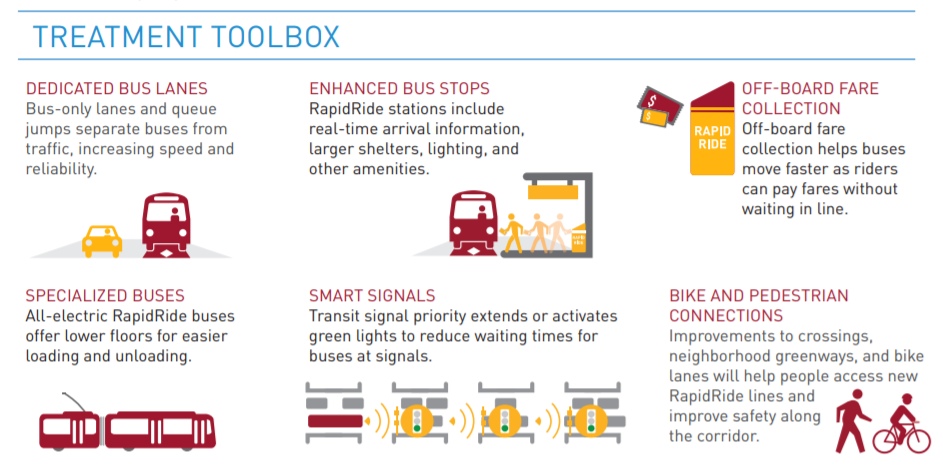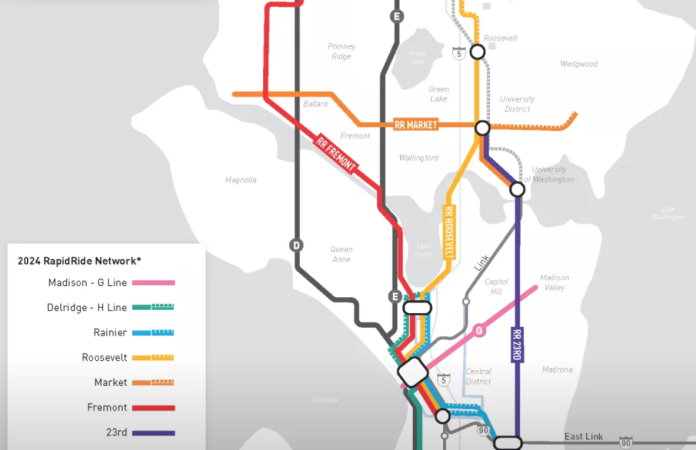The rumors of the Move Seattle Reset have been swirling for months, but it remained unclear what that would mean beyond a sort of vague watering down of upgrades due to an estimated $96 million shortfall.
Now it’s become clearer that the City is planning to abandon three of its seven RapidRide projects promised in the 2015 Move Seattle levy due to a shortage of funding–and perhaps a lack of desire to raise more. A King County Metro Transit Capital Improvement Plan (CIP) released Monday showed only four Seattle RapidRides planned through 2027–three other planned RapidRides are in South King and East King County. The fourth is listed as Roosevelt Rapidride, but the narrative suggests that is provisional. The last four projects may have to duke it out for the final RapidRide slot, hunger games style.
Current Scope: Roosevelt/K Line RapidRide – This project would build a yet to be specified RapidRide corridor within the City of Seattle Currently the city has several candidate corridors (Roosevelt, Routes, 40 , 44 & 48). Metro is working with SDOT to convert one these efforts to a RapidRide corridor for an opening date of 2025. This project would plan, design and implement the necessary infrastructure improvements to launch RapidRide service. These infrastructure projects include passenger facilities, roadway, signal and intelligent transportation system (ITS) improvements which result in better transit speed and reliability, access to transit projects–which reduce barriers for people to reach transit–and necessary communication and technology efforts to support the service. This budget also includes the associated costs for public outreach and marketing. This budget does not include vehicles.
“The [seven] RapidRide lines Seattle identified remain in the Metro Connects vision plan, and upcoming and future CIPs will clarify how and when those routes will be implemented,” Metro’s Jeff Switzer said in an interview with Seattle Transit Blog.
Update: After publication, King County Metro spokesperson Jeff Switzer confirmed that money will be allocated to the Roosevelt Rapid Ride: “Funding to open a RapidRide line serving downtown Seattle-Eastlake-UDistrict-Roosevelt in 2024 is included in the King County Metro proposed CIP.”
Transit hunger games
The abandoned RapidRide lines are those last in line. Most likely the cuts will be Routes 44, 40, and 48, promised in 2022, 2023, and 2024 respectively. If this stands, North Seattle and the Central Area will miss out on promised transit upgrades. If Roosevelt (Route 70) ends up getting cut, this would also be a blow to Eastlake in addition to Northeast Seattle. If a Roosevelt RapidRide doesn’t happen hopefully that means an Eastlake protected bike lane will happen, since the the City had been pitting the two options against each other.
The surviving Seattle RapidRide projects have been delayed significantly from timelines presented during the Move Seattle campaign. The reset has pushed Rainier Avenue (Route 7) back to 2024, and the mystery fourth project assumed to be Roosevelt to 2024 or 2025. The Rainier Rapidride had originally been promised in 2020, and Roosevelt in 2021. Delridge’s RapidRide H (Route 120) and Madison Street’s RapidRide G appear on track for 2021 openings–though both had been delayed off their initial 2019 targets.
RapidRide Rollout Schedule after "Reset"
| RapidRide Corridor | 1st Revision | Reset Date | Existing Route | 2015 Daily Ridership | 2016 Daily Ridership | Platform Hours |
|---|---|---|---|---|---|---|
| Madison "G" | 2021 | 2021 | 12 | 3,500 | 3,300 | 84 |
| Delridge "H" | 2020 | 2021 | 120 | 8,700 | 8,600 | 226 |
| Rainier | 2021 | 2024 | 7 | 11,500 | 10,800 | 255 |
| Roosevelt | 2021 | 2024 | 70 | 5,300 | 7,500 | 182 |
| Market/45th St | 2022 | cut? | 44 | 7,500 | 8,400 | 167 |
| Fremont | 2023 | cut? | 40 | 10,600 | 11,400 | 284 |
| E 23rd Ave | 2024 | cut? | 48 | 11,200 | 5,500 | 183 |
| West Seattle | 2012 | 2012 | C | 8,800 | 11,100 | 289 |
| 15th Ave NW | 2012 | 2012 | D | 11,800 | 14,300 | 256 |
| Aurora Ave | 2014 | 2014 | E | 15,800 | 17,000 | 299 |
The City of Seattle has cited a dearth of federal grants paired with an over-leveraged plan as the reason for these RapidRide delays and cuts. The election of Trump has meant transit funding has withered on the vine. Even when grants have already been approved, Secretary Elaine Chao’s Federal Transit Administration has often refused to allocate the money in a timely fashion putting projects in limbo. Recently, Lynnwood Link did make progress on pocketing $100 million in federal grants, giving some hope that some transit grants would make it through the Republican gauntlet.

That blow, along with a mayor who wants to make her name cutting City budgets rather than expanding them, could be creating a perfect austerity storm for voter-approved rapid bus transit projects.

Keeping promises to Move Seattle voters
Not delivering on three promised RapidRide projects is going to be a tough pill to swallow for Seattle voters who overwhelmingly supported the levy’s plan–58.7% of voters supported it. While the ballot language itself was vague on the number of bus upgrades, the official statement in favor (which was printed in voter packets) did promise seven bus rapid transit corridors. A bullet point in the statement called out the following neighborhoods:
Builds a network of seven bus rapid transit corridors to connect neighborhoods with fast and reliable transit, including Ballard, Delridge, Capitol Hill, Madison Valley, Eastlake, Roosevelt, Rainier Valley, Central District, Wallingford, Fremont, U-District, and Northgate.
Not fulfilling the promises made to those neighborhoods would hurt the City’s trust with voters and make it harder to pass future transportation levies. On the other hand, so would producing subpar RapidRide lines, which is why Frank Chiachiere commended the focus on four lines to (hopefully) full RapidRide standards.

Salvaging RapidRide plans
But maybe there’s still a way to deliver meaningful upgrades on all seven corridors?
Funding is going to be scarcer than anticipated since the federal government is skimping and sabotaging transit right as skyrocketing construction costs is hitting projects throughout the Puget Sound Region. That means we have to spend what money we do have wisely. (Raising more revenue should also be on the table. Perhaps revenues from carbon pollution fee–assuming it passes–could be directed toward RapidRide projects?)

Here’s some high impact, but relatively low cost ways to speed up buses and improve the quality of transit service.
- Paint dedicated bus lanes ASAP so people-packed buses don’t have to wait behind people in single occupant vehicles (SOVs). And since Rainier RapidRide appears delayed to 2024, bus lanes shouldn’t wait that long. We have a plan for a northbound Rainier Avenue bus lane. Let’s paint it red now to start saving commuters time.
- Camera enforcement of bus lanes so packed buses in transit lanes don’t have to wait behind scofflaw SOV drivers and Uber and Lyft drivers.
- All door boarding via off-board payment at each stop.
- Queue jumps so buses can get a head start at congested intersections.
- Higher frequencies so riders don’t have to wait as long for their bus and experience crowding less frequently.
On the other hand, some typical RapidRide upgrades are less cost-effective and could wait for future funding.
- Fancy buses. RapidRide branding is nice, but the important thing is getting service upgrades rolled out, regardless of brand. Using mostly existing bus stock should reduce costs and avoid delays. Trouble procuring custom buses with doors on both sides to make Madison Street’s center lane work is holding up the RapidRide G Line, potentially further delaying the project
- Fancy shelters. It’s nice to get real-time arrival information and have a spacious shelter from the rain for big crowds waiting for a bus. However, it’s a lower priority than ensuring bus service is faster. It’s too bad the Durkan administration has indefinitely shelved a proposal that could have brought in ad revenue and secured free transit shelter upgrades via its vendor Intersection in exchange for rights to electronic ads at the stops. If successful, that proposal could potentially have been expanded from the downtown core to spread upgrades along the busiest bus corridors.
- Street rebuilds. It’s nice to get a repaved street as part of RapidRide, but it’s also not essential to delivering improved transit service.
It’s nice to finally have a bit of clarity on RapidRide plans and what the Move Seattle Reset will look like. There’s too much at stake for this to only be debated in the footnote of a budget. It’s time for this discussion to be more public. Mayor Durkan boasted of $130 million more dollars invested in transportation next year, but it appears that rapid bus transit corridor plans are still feeling a money crunch.
The less-than-RapidRide upgrades that are being planned for the 40, 44, and 48 should be brought out in the open. If they appear lacking, maybe we should raise more revenue so promises to voters can be kept. Contact your Seattle City Councilmembers and your King County Councilmembers and call Mayor Jenny Durkan at 206-684-4000.

Owen Pickford
Owen is a solutions engineer for a software company. He has an amateur interest in urban policy, focusing on housing. His primary mode is a bicycle but isn't ashamed of riding down the hill and taking the bus back up. Feel free to tweet at him: @pickovven.

